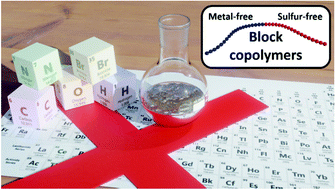Bromoform-assisted aqueous free radical polymerisation: a simple, inexpensive route for the preparation of block copolymers†
Abstract
In the quest for commercially relevant block copolymer additives, for which overall average molecular composition is key but molar mass distribution is of little importance, we present a straightforward, sulfur- and metal-free aqueous route to block copolymers using commercially available starting materials. Based on synthetic techniques first described in the 1950s for hydrophobic monomers in organic solvents, we have shown that bromoform (CHBr3) can be used to create block copolymers. Unlike common bromine-containing chain transfer agents such as carbon tetrabromide (CBr4), bromoform is partially water-miscible and relatively inexpensive. Herein, we demonstrate this new aqueous-based technology using N,N-dimethylacrylamide (DMA) and N-isopropylacrylamide (NIPAM) as exemplar monomers to synthesise PDMA-b-PNIPAM block copolymers of varying composition directly in water. This study demonstrates the potential for such a simple, inexpensive route to functional block copolymers where further research to decipher the detailed mechanism and true potential of this technique will be of great value.

- This article is part of the themed collection: Synthetic Methodologies for Complex Macromolecular Structures


 Please wait while we load your content...
Please wait while we load your content...